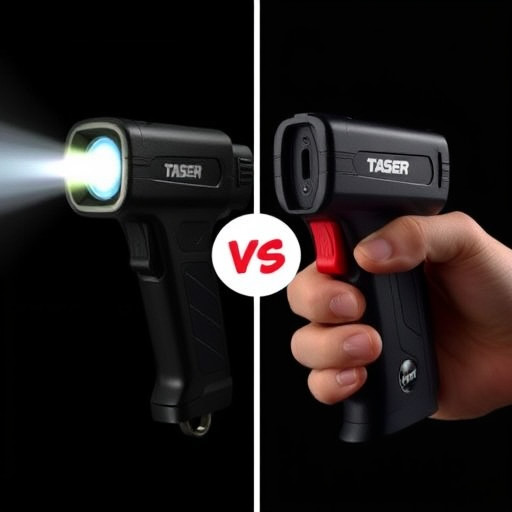In the realm of personal safety, stun guns and tasers have emerged as controversial yet potent tools. This article delves into the effectiveness—and stark differences—between these two non-lethal weapons in real-life scenarios. We explore how each device works, their success rates, limitations, legal implications, and situational use cases where one might prove more effective than the other. Armed with this knowledge, folks can make informed decisions about self-defense.
Understanding Stun Guns and Tasers: A Basic Overview
Stun guns and tasers are both non-lethal weapons designed to incapacitate an attacker, but they operate on different principles. A stun gun delivers a strong electric shock through metal prongs or contacts, disrupting muscle control in the target area. This causes temporary paralysis, allowing the user to escape or subdue the assailant. Stun guns are easy to use and require minimal training, making them popular among personal protection enthusiasts and self-defense advocates.
Tasers, on the other hand, use two thin probes connected by a wire to deliver a high-voltage, low-current electrical pulse. This pulse causes intense muscle contractions, leading to temporary incapacitation. Unlike stun guns, tasers can be used at a safer distance, as the probes attach to the target, delivering the shock remotely. The difference between stun guns and tasers lies in their deployment methods, effectiveness ranges, and the level of physical contact required, making them suitable for diverse self-defense scenarios.
– Definition and function of stun guns and tasers
Stun guns and tasers are both non-lethal weapons designed to incapacitate individuals, but they operate on distinct principles. A stun gun delivers a powerful electric current through metal probes or contacts, causing severe pain, muscle spasms, and temporary paralysis in the target. It’s effective for immobilizing an opponent without causing permanent harm. On the other hand, a taser uses two thin, conductive probes connected to a high-voltage, low-current electrical pulse generator. When activated, the taser fires these probes into the target, delivering a controlled electric shock that disrupts muscle control, resulting in temporary incapacitation.
The primary difference between stun guns and tasers lies in their firing mechanism and range. Stun guns typically require direct contact with the target, while tasers can fire probes from a distance, allowing for more versatility in diverse scenarios. Moreover, tasers are generally considered safer because they deliver less current than stun guns, minimizing the risk of serious injury or death, even when used on individuals with medical conditions.
– How they work in de-escalating situations
Stun guns and tasers are both non-lethal weapons designed to immobilize targets, but they operate with distinct mechanisms that impact their effectiveness in de-escalating situations. Stun guns emit a strong electrical pulse that overrides the target’s motor functions, causing muscle spasms and temporary paralysis. This shock can be incredibly disorienting, giving users or bystanders time to escape or intervene. In contrast, tasers fire two small probes connected to cables that deliver an electric current between them, disrupting neural signals and causing intense but localized discomfort and immobilization.
The difference between stun guns and tasers lies in their range and impact area. Tasers generally have a longer reach—up to 30 feet—and can incapacitate multiple targets simultaneously due to the probes’ ability to attach and fire at different subjects. Stun guns, on the other hand, typically require direct contact or close proximity, making them more suitable for personal defense scenarios where a user might be in close quarters with their assailant. Both devices serve critical roles in law enforcement and self-defense, offering non-lethal options to defuse potentially dangerous situations.
Effectiveness in Real-Life Scenarios: Stun Guns
Stun guns, a popular choice for personal defense, operate by delivering an electric shock that temporarily paralyzes the target, providing users with an opportunity to escape or subdue an assailant. Their effectiveness in real-life scenarios lies in their ability to incapacitate an attacker quickly and surprisingly. Unlike tasers, stun guns require direct contact to deliver a jolt, making them more suitable for close-quarters encounters. This difference has practical implications: users must be within arm’s length of the target, offering a strategic advantage in tight or confined spaces.
However, stun guns have limitations. The level of force they exert is generally lower than that of tasers, which can make them less effective against larger, stronger individuals. Moreover, factors like weather conditions and the target’s body type can influence their performance. Despite these considerations, stun guns remain a preferred choice for many due to their ease of use and relatively low risk of causing serious injury compared to firearms or other more potent self-defense tools.
